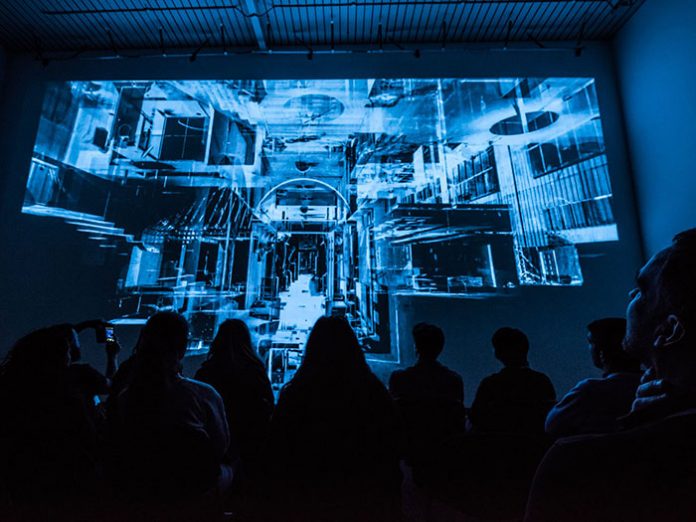Based in Glasgow’s Digital Media Quarter, Glasgow School of Art’s School of Simulation and Visualisation (SimVis) – formerly The Digital Design Studio – is an immersive visualisation centre for commercial and postgraduate research where the highest quality visualisation is the very nucleus of every project undertaken.
Guided by the expertise of Antycip Simulation, the need for a high brightness, 4K resolution, 3D stereoscopic projection solution was fully met by Digital Projection’s Insight Laser 4K.
SimVis operates across three main areas: research such as cutting-edge medical and heritage visualisation, commercial projects and academic research from a number of post graduate degree programmes. Though each area is self-funding, large amounts of the commercial and medical research seeps into the academic arm so students are continually exposed to a broad range of projects from virtual reality computer games to heritage visualisation.
Dr Paul Chapman is acting director of SimVis. As a chartered engineer, a chartered IT professional, award-winning and academically decorated up to PhD level in Computer Science, Dr Chapman explores real-world problems across diverse disciplines through simulation and visualisation. He states, “We’re all very passionate about computer graphics and virtual reality and that passion means that through the state-of-the-art work we do, we have become world leaders in this area. We love what we do and we do it very well and that leads to the high quality of projects we get. Good projection facilities are very important for our work.”
John Mould, commercial development manager for Antycip Simulation describes the criteria upon which the projection solution was based, “SimVis wanted a projector that provided higher brightness than the existing solution in place, native 4K resolution with 120hz active stereo output capability.” The size of the projector was important so projectors requiring active heat extraction measures were ruled out. “Finally, we were looking for a projector that could also address optical requirements for the throw distance and image width for the SimVis’ 11.4 x 6.4 metre projection wall.”
Explaining the choice of Digital Projection Insight Laser 4K, Mould continues, “Digital Projection was quick to market bringing a family of laser light source based products and the attributes of this model ticked the boxes of what we understood the customer required. Many of the market alternatives at the time did not feature the benefits of laser light sources and relied upon Xenon lamps, which whilst extremely bright do require more specialist attentions from a maintenance point of view and direct connection to three phase power combined with active heat extraction measures.”
The Insight Laser 4K offers 12,000 lumens of solid-state illumination at an advanced resolution of 4096 × 2160, well-suited to the needs of visualisation where image detail and image stability are of the utmost importance. The consistent solid-state illumination performance of the Insight 4K from Digital Projection ensures impressive images and limited maintenance, saving both time and servicing costs.
The vast size of the projection wall presented difficulties. SimVis wanted to increase the quality and fidelity of the display whilst at the same time also increases the intensity of the light to the display surface. They did not, however, want a multiple projector array with blending technologies to afford such a large image.
Mould explains, “Digital Projection’s Insight Laser 4K not only offers the ideal native 4K resolution of 4096 x 2160 but delivers this whilst also offering more “green” credentials, lower maintenance intervals and longevity of the light source which is rated to operate beyond 20,000hrs. The pixel size was dramatically reduced offering the possibility to support picture in picture capabilities with up to 4 x HD and ensuring fantastic colour reproduction for any applications featured.”
To enable such a large image from a relatively short distance a specialist Schneider lens was selected. The image is geometry corrected using Vioso’s Anyblend software to correctly address and map the display surface.
Antycip Simulation engineers carried out the single phase installation in under a week. A custom projector mounting platform was assembled to elevate the Insight Laser 4K projector. I-beams tracking across the theatre infrastructure prevented a ceiling mount. The engineers also attached the optics before finally addressing the geometry correction to the projection axis.
A Cyber Station image generator from Broadberry was also installed, featuring a flagship Nvidia graphics card to ensure the demanding 4K content could be realised and able to cope with current and future demands for both animated and real-time content. Visual content is fed directly to the projector via a single 15-metre Ophit fibre optic cable.
Completing the full solution, an array of over twenty Vicon spatial tracking cameras track dynamic entities, using the tracker software, and Volfoni RF-based VR glasses enable the 3D capabilities to be realised by the audience.
Mould viewed the complete project as a successful deployment addressing the client’s particular requirements, commenting, “We were very pleased with the final result of the laser projector.”
“The biggest challenge was the precise placement of the projector, its light path and what angle we needed to pitch the optics from the existing platform. In an ideal world, modifications to the building would have allowed us to project perfectly on axis to the display surface and avoid any slight digital corrections but technology exists to achieve results in the face of such architectural challenges and avoided costly and extensive building alterations.”
Chapman and SimVis are delighted with the final solution. “I relied upon the expertise of Antycip and that trust has been repaid. The new projector is much better than the previous one, not only much brighter but the resolution is much greater giving much more definition to and clarity in the image.”
“The RF glasses reduce the brightness of the image so now the image we see with the glasses on is much brighter than previously and we can get close to the wall without seeing all the pixels – the quality and resolution is much better – which offers benefits to all our arms of research.”





